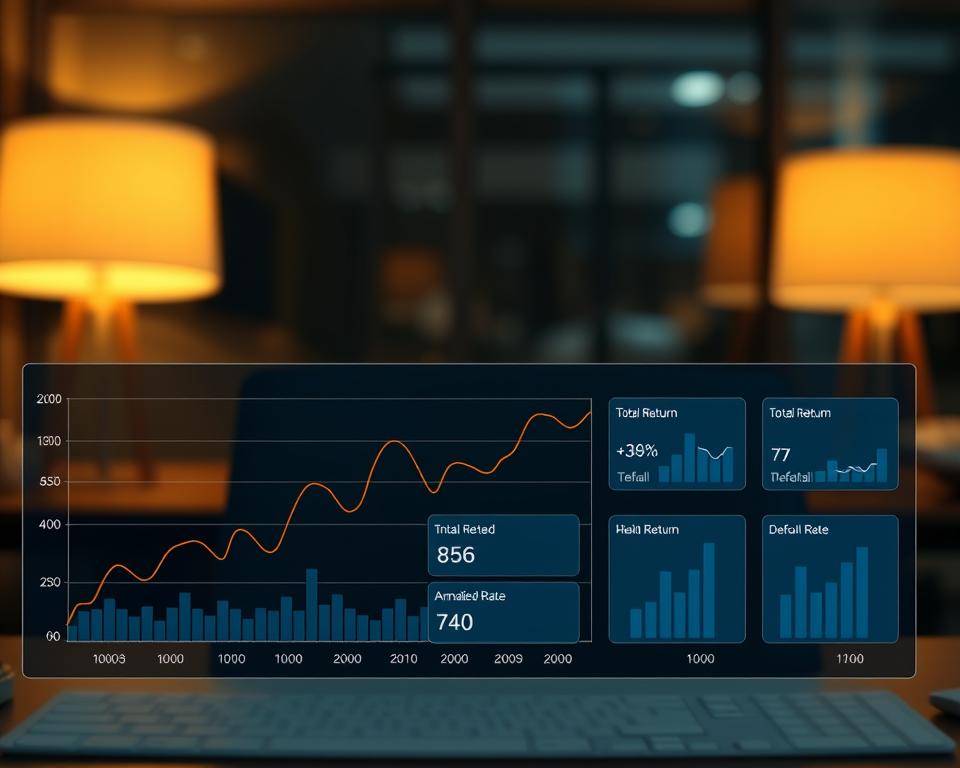Oversee Your CLO Equity Results Productively
Have you discovered that CLOs within the United States have grown into an vast $1.1 trillion sector? This growth is not merely a matter of figures. It mirrors the economical arena’s complexity and CLO capital’s budding position for investors such as big pension funds and family offices. The emergence of sophisticated stakeholders in CLOs underscores the necessity of commanding CLO capital performance monitoring.
Investing in CLO equity investments provides many benefits, appealing to a wide range of stakeholders. The possibility of significant gains and steady cash disbursements constitutes CLO funds a valuable addition to varied portfolios. This distinctive offering highlights their attractiveness. Stakeholders are captivated by CLO share on account of its high return potential, often aiming for mid-teens returns, similar to those sought in private equity. This charm endures, in spite of fluctuating interest rates and economic adjustments. CLOs, with their 150-200 diverse positions, provide a level of stability infrequent in more focused portfolios. I aim to provide you with the key metrics and insights for equity CLO performance, helping you make savvy investment choices.
Understanding CLOs: A Exhaustive Overview
CLOs are intricate financial tools. They aggregate diverse leveraged loans, selling them in slices to investors. Grasping CLOs is essential as they offer corporate financing solutions. Across three decades and a half, their evolution has profoundly changed capital strategies for institutions. This section offers an understanding of the CLO market’s history and current dynamics. It spotlights important patterns and features influencing participants.
What exactly is a CLO?
CLOs present a novel approach for handling borrowed funds. They combine in excess of 200 sub-investment-grade, strongly secured corporate credits. This strategy aims to minimize risk while producing attractive yields. The United States CLO market is booming, now toppling $1 trillion as of March 2024. Growth has been approximately 10% annually since 2012. Despite a slowdown in growth to about 6% in 2023, a small decrease to 1% is foreseen in early 2024. Notably, the top-rated segments, AAA and AA, have never defaulted, underscoring CLOs’ stability.
Growth and Evolution of CLOs over the Years
The trajectory of CLOs is notably marked by their robustness in the face of financial slumps. The financial crisis proved this sturdiness; CLOs preserved strong credit standing with low default rates, unlike corporate bonds. Following a decline to $263 billion in the post-crisis period, the market rebounded remarkably. By September 2023, it climbed to $970 billion. This increase showcases their trustworthiness amidst current CLO market dynamics.
New techniques, such as CLO ETFs, have propelled the market even further. It’s now valued at $15 billion, due to increased trading and liquidity. In the United States, a new CLO deal averages around $500 million. In Europe, deals are somewhat smaller, normally €400 million. The bulk, sixty to sixty-five percent, goes to senior tranches. The equity segment constitute about approximately 9 to 10%.
From grasping CLO basics to grasping their progress and current trends, it’s clear they’re vital in financial markets. They notably reconcile risk against return for investors.
The Appeal of CLO Equity Investments
Allocating funds to CLO equity investments offers many benefits, appealing to a broad spectrum of investors. The potential for high returns and regular cash distributions makes CLO funds a worthwhile component to diverse portfolios. This unique value proposition underscores their appeal.
Key Benefits for Investors
CLO capital stands out for its potential double-digit returns. Forecasts suggest returns of low to mid-teens returns. Consistent cash disbursements add to the attraction of CLO funds, especially for those seeking steady income. Additionally, strong market fundamentals, including low default incidences, increase confidence in these investments.
Historically, CLO equity has recorded reduced default rates than standard debt products. Despite potential financial stress in some sectors, expected default rates should remain low. In times of recession, high loan spreads can benefit CLO investors. This allows for smart loan selection to reduce anticipated losses.
CLO Equity Compared to Other Asset Types
Comparing CLO share to other investments underscores its unique benefits. It provides higher liquidity than private equity investments while maintaining returns. Despite recent spread compression, CLOs offer superior yields than debt of similar ratings, demonstrating its allure.
| Asset Class | Yields | Failure Rates | Liquidity |
|---|---|---|---|
| CLO Equity | Low to Mid-Teens | Lower than debt instruments | Moderate; less liquid than Treasuries |
| Private Equity | Varies; typically lower liquidity | Variable, depending on market phase | Low; often illiquid |
| High-Yield Bonds | Higher than Treasuries | Higher default rates than CLOs | High; more liquid |
The demand for CLOs remains strong, suggesting an optimistic forecast for 2024. Competitive financing rates, due to a favorable spread balance, add to this opportunity. For those maneuvering through the volatile market, an insight into CLO equity can be crucial for efficient strategy formulation.

Monitoring CLO Equity Performance: Metrics and Tools
For investors focused on maximizing returns, accurate tracking of CLO equity performance is vital in the complex financial arena. Effective use of CLO equity performance metrics significantly boosts investment strategies. Comprehending essential performance indicators (KPIs), like cash flow allocations, net asset value, and operating expense ratios is imperative. They provide profound understanding of the functional efficiency of CLO holdings.
Essential KPIs for CLO Capital
CLO shareholders monitor various KPIs to effectively measure performance. Key metrics include:
- IRR: An essential measure for appraising extended profitability.
- Cash-on-Cash Return: Offers insights into how cash distributions compare to invested capital.
- Net Asset Value (NAV): Indicates the market value of a firm’s assets, critical for CLO valuation.
- Payout Ratio: Usually approximates 50% of cash flows from assets.
- Default Rates: Historically range between 2% and 3%, with an average 70% recovery rate for defaulted loans.
Optimally Employing Tracking Mechanisms
For successful management of CLO equity investments, which account for over $600 billion globally, effective tracking tools are vital. Enterprises like Flat Rock Global provide dedicated instruments for monitoring CLO equity performance. These tools empower participants to effectively oversee their asset holdings.
These tools assist in analyzing performance metric trends and benchmarking against indices like the CLO Index from J.P. Morgan. They also enable comparisons to broader indices such as the Bloomberg Aggregate Bond Index and the BofA US Corporate Index by ICE.
Making informed decisions to optimize CLO equity performance is attainable for investors leveraging these metrics and tools. This understanding and effective utilization pave the way for successful CLO management strategies.
Economic Trends Affecting CLO Share Performance
Exploring the what is CLO market trends needs a thorough analysis of the economic environment and its effect on investments. Growth statistics highlight a strong market, providing critical insights to investors. By November 2024, U.S. CLO issuances reached $191 billion, a 72% rise from the prior year. This underlines an growing allure of CLOs during economic transitions.
Present Market Environment
CLO volume has climbed to $465 billion, surpassing the 2021 high of $438 billion. In October 2024, new issuances reached $59 billion, and subsequently, November delivered $26 billion, ranking as its second-best. The market increased by 1% from the start of the year, reaching a total of $1.046 trillion. Additionally, the surge in PCLOs with a $36 billion new issuance, set a new record.
Influence of Interest Rates on CLO Share Performance
Escalating interest rates profoundly influence CLO capital, largely owing to their adjustable-rate characteristic. This makes CLO investments increasingly appealing for participants desiring elevated gains in a fluctuating market. Estimates imply CLO issuances in 2025 could range from $180 billion and $215 billion, propelled by supportive elements. Watching the default rate, which improved from 3.3% in January 2024 to 3.1% at Q1’s end, is vital for CLO stakeholders. This evolving scene allows for portfolio adjustments amidst current CLO equity market movements.
Dynamic Management Tactics for CLO Shares
Overseeing CLO equity investments necessitates proactive management. Through strategic market navigation, CLO equity managers seek to enhance yields while reducing risks. These managers understand the complexities of the market. This insight markedly affects the success of participant investments.
How Managers Drive Performance
CLO portfolio overseers are key to boosting portfolio results. They keep a close eye on the loan credit quality and pricing. With this information, they capitalize on market openings. Such attentiveness allows for quick adaptations to market dynamics, enhancing CLO distribution yields. Low default incidences and minimal correlation with risky assets, such as the average US corporate 5-year cumulative default rate demonstrate CLOs’ investment desirability.
CLO Management Risk Mitigation Strategies
CLO investment managers employ diverse methods to guard against financial risks. These tactics are vital for safeguarding stakeholders during volatile market periods. They concentrate on the difference between asset spreads and debt costs to optimize cash flows. The diverse internal rates of return (IRRs) in CLO equity, with top quartiles reaching up to 25% and bottom quartiles sometimes falling below 0%, show the importance of these mitigation strategies’ significance in maintaining investment stability through market changes.
CLO Indexing and Benchmarking Significance
Grasping the function of the CLO index is crucial for making informed equity investment choices. It acts as a barometer for CLO equity, reflecting market dynamics and guiding investor strategies. Through the analysis of these indices, we gain deep insights into various performance metrics of CLOs. This helps us compare risk and trend patterns across distinct asset categories effectively.
Interpreting CLO Index Results
The CLO market’s magnitude has reached an astonishing $1.2 trillion. It now satisfies about 70% of the demand for US corporate loans. Such expansion underscores the need for reliable benchmarks. Here, CLO indices play a crucial role. They assess a broad spectrum of performance metrics, permitting investors to evaluate their holdings against the broader market.
Comparative Analysis with Other Indices
Evaluating CLO performance in comparison to other indices sheds light on its positioning. Commonly, CLO equity maintains a roughly 90% debt and 10% equity structure. In terms of safety, AAA tranches demonstrate nearly zero defaults. This is in direct opposition to the long-term average default rates of US corporations. Hence, CLOs stand out for their appealing returns and exceptional stability within fixed-income assets.
Moreover, CLO performance metrics often point to a spread benefit over traditional bonds, particularly in the high-yield sectors. This translates into higher potential gains for investors along with valuable diversification perks. CLOs show a lesser correlation with other high-yield bonds and equities, enabling smarter CLO market positioning and more insightful investment strategy development.
Obstacles in Overseeing CLO Share Performance
Monitoring CLO share performance is notably challenging, especially when markets are volatile. Investors encounter complexities due to market variability that affect risk evaluations and the identification of opportunities. These fluctuations can substantially influence default probabilities and purchasing decisions. Hence, deploying effective strategies is essential for sustaining prime CLO performance.
Market Turbulence and Consequences
Bond market projections implies that fixed income stakeholders are moving towards dynamic management strategies. This change aims to better adapt to ongoing market volatility, improving returns for fixed income portfolios. We’re in an evolving credit cycle, not yet at its peak, hinting at continuous credit portfolio opportunities through 2025. Given elevated interest rates, CLO monitoring challenges are pronounced, elevating capital costs for CLO equity and underscoring the need for judicious management.
Understanding Default Risks in CLO Investments
It is essential to understand the default risks associated with CLO investments for proper monitoring. Evidence suggests that during market declines, CLO loan default percentages may approach 3%, negatively impacting performance. The combination of elevated interest rates and reduced returns across various investment strategies adds to the complexity. Remarkably, about 40% of CLO managers are now leveraging advanced analytics and AI to improve their tracking, resolving transparency concerns and advancing performance metrics. The complexity of the assets underneath and ongoing regulatory changes introduce additional challenges in managing CLO equity performance effectively.
Forthcoming Prospects for CLO Share Investments
The landscape of CLOs is witnessing a transformation. This change heralds a future for CLO equity investments defined by potential and complexity. Insights into market trends highlight considerable opportunities arising from variations in supply, demand, and interest rates. A significant leap in new issuances in 2024, totaling $199.8 billion heralds a vigorous recovery. This figure is 72% higher than 2023’s and surpasses previous records, cementing CLO equity’s role in the investment sphere.
Historic refinancing and reset operations, reaching $309.1 billion in 2024, reinforce investor trust in CLOs. This reveals promising prospects, especially for those ready to steer through the changing market dynamics.
Potential Opportunities in the Current Landscape
Given upcoming regulatory adjustments like Basel III, an injection of about $190 billion could strengthen the market. These changes aim to bolster the appeal of AAA, AA, and single-A CLO tranches, anticipated to trigger a demand surge. CLOs continue to offer attractive total returns, especially within lower-rated segments. This showcases their impressive performance and the risk-adjusted rewards they carry.
Forecasted Developments and Shifts to Monitor
Several forecasted shifts in CLO investment demand attention. The potential for narrower spreads and improved liquidity looms, influencing investment approaches. The historical resilience against defaults makes CLO equity a comparatively secure option in uncertain markets. With robust issuance anticipated in 2025, savvy investors ready to revise their strategies could realize significant returns amid changing conditions. Investors should vigilantly monitor secondary equity positions for attractive cash-on-cash yields.
Conclusion
To sum up, effectively tracking CLO equity performance is crucial for investors entering this distinct asset class. With the CLO market now valued at over $1.1 trillion, with CLO equity making up about $100 billion, it’s evident. These investments offer strategic advantages not to be overlooked.
The significance of proactive management in elevating CLO performance during vital reinvestment intervals is paramount. Given the CLO market’s fluctuations—including interest rates, market conditions, and deal timings, it’s vital that investors keep abreast and act proactively. This strategy allows for adaptive approaches to optimize CLO investment opportunities.
For savvy investors, engaging with CLO equity reveals notable professional prospects. The mix of diversification benefits and the chance for significant returns demonstrates that CLO equity is an essential component of diversified portfolios. Looking to the future, staying current with market trends and actively participating in the CLO arena promises significant gains. This underscores the value of a meticulous CLO investment strategy.
FAQ
How would you define a CLO?
Collateralized loan obligations (CLOs) merge multiple leveraged loans, which are then divided and marketed to investors, thereby providing a unique avenue for engaging in corporate finance.
What are the main benefits of investing in CLO equity?
CLO equity investments deliver substantial benefits such as elevated returns, steady cash flows, low correlation with other asset types, and the possibility of enhanced performance through expert management.
How can one monitor CLO equity performance?
One should track CLO equity by emphasizing key performance metrics like cash flow distributions, NAV, and expense ratios, complemented by specialized tools from companies such as Flat Rock Global.
What current market trends affect CLO equity performance?
CLO equity performance is heavily influenced by market trends like interest rate variations and economic conditions, with floating-rate features potentially leading to increased returns when rates rise.
How are CLO equity returns boosted by managers?
CLO managers elevate equity returns by engaging in strategic trading, meticulous risk management, and by closely monitoring loan credit quality and pricing, adapting as the market evolves.
Why are CLO indices important for assessing performance?
CLO indices are vital for evaluating performance. They help investors compare the success of CLO equity to broader market measures. This aids in understanding the risk-return dynamics.
What are the difficulties in monitoring CLO equity performance?
The challenges in monitoring CLO equity performance include navigating market volatility, which impacts default risk assessments and acquisition timing, thereby requiring ongoing scrutiny of underlying loans.
What does the future outlook for CLO equity investments look like?
Prospects for CLO equity investments appear promising, with an evolving market environment and anticipated interest rate changes offering potential for strategy refinement.

